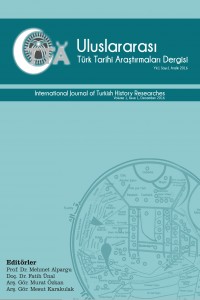Uzak Doğu Türk-Tatarlarının Dinî ve Maarif Faaliyetleri Hakkında Bir Belge: Keijo (Seul) Mescid ve Mekteb-i Numanî Nizamnamesi
Öz
Rus İhtilali, Çarlık
idaresi altındaki Türk halklarını da olumsuz şekilde etkilemiştir. İç savaş
sırasında hem Kızıl Ordu, hem de karşısındaki Çar taraftarı orduların içinde
Türk haklarına mensup unsurlar bulunuyordu. Bolşevik zaferinin ardından, Çar
ordularında bulunan binlerce İdil-Ural Türk-Tatarı, Japon kontrolü altındaki
Mançurya'ya ve ardından Japonya'nın onayıyla Kore ve Japonya'ya geçmeye
başlamışlardır. Bu iltica hareketinin ardından birçok Türk-Tatar ailesi de bu
bölgelere göç etmiştir. Yerleştikleri bu bölgelerde Mahalleyi İslâmiyeler
kurarak topluluk halinde bir arada yaşamışlardır. Mahalleyi İslâmiye
Cemiyetleri kurduktan sonra, dinî ve maarif faaliyetlerine girerek okullar ve
camiler kurmuşlardır.
Özellikle Japonya'daki eğitim faaliyetleri
hakkında kaynak niteliğinde belgeler mevcutsa da Kore'deki faaliyetler hakkında
fazla bilgi ve belge yoktur. Kore'nin Keijo (Seul) şehrinde Türk-Tatarların
kurduğu, okul ve mescitle ilgili, Keijo
Mescid ve Mekteb-i Numanî Nizamnamesi, eldeki en önemli belgelerden
biridir. Bu makalede, adı geçen nizamname Japonca ve Tatarca versiyonları
karşılaştırılarak Türkçeye aktarılmış ve araştırmacıların dikkatine
sunulmuştur.
Anahtar Kelimeler
Kore Türk-Tatarları Numani Mescid ve Mektebi Türk-Kore İlişkileri Doğu Asya'da Türkler
Kaynakça
- Hee-Soo Lee, İslâm ve Türk Kültürü’nün Uzak Doğu’ya Yayılması, Türkiye Diyanet Vakfı, Ankara, 1991, s. 271-278.
- A. Merthan Dündar, Japonya’da Türk İzleri: Bir Kültür Mirası Olarak Mançurya ve Japonya Türk-Tatar Camileri, Vadi Yayınları, Ankara, 2008.
- A. Merthan Dündar, “Japonya'da Bir Başkurt Önder: Molla Muhammed Gabdulhay Kurbangaliyef”, Tarihten Bugüne Başkurtlar, Tarih, Dil ve Kültür Üzerine İncelemeler, Haz. A. Melek Özyetgin, A. Merthan Dündar, İlyas Kamalov, Ötüken: Ankara 2008, s. 132-162.
- A. Merthan Dündar, “Japon Resmi Belgelerine Göre Ayaz İshaki ve Japonya’daki Faaliyetleri”, Türk Yurdu, Cilt 31, Sayı. 287, Ankara 2011, s. 100-105.
- A. Merthan Dündar, Panislâmizm'den Büyük Asyacılığa: Osmanlı İmparatorluğu, Japonya ve Orta Asya, Ötüken Yayınevi, II. Baskı, İstanbul 2012.
A Document on the Religous and the Educational Activities of the Turco-Tatars of the Far East: The Ordinance of Keijo (Seoul) Mescid ve Mekteb-i Numanî
Öz
The Russian revolution, affected adversely the Turkic population of
tsarist Russia. During the civil war, there were existing elements from
different Turkic nations both in red army and tsarist armies. After the
bolshevist victory, thousands of Turko-Tatars of Volga-Ural went out to the
Manchuria which was under control of Japan at that time and after Manchuria, some
groups went to Korea and Japan by the consent of Japanese government. Following
this defection movement, many Turko-Tatar families immigrated to these regions
too. They established Mahalle-i Islâmiyes (Islamic neighborhoods) and tried to
live as communities. After the founding of associations called Mahalle-i Islâmiye,
they proceeded to go into action for founding camiis and schools.
There are existing, first hand historical documents relating to the
education activities of Turko-Tatars in Japan but there aren't much records
about this kind of activities which occurred in Korea. The Keijo Mescid ve Mekteb-i
Numanî Nizamnamesi is one of the most important document concerning about
the school and the mescid which was founded by Turko-Tatars in Keijo city (Seoul).
In this article, the mentioned regulation was translated into Turkish in
comparison with the Japanese and Tatar versions and presented to the attention
of the researchers.
Anahtar Kelimeler
Turko-Tatars of Korea Numani Mescid andMektebi Turkish-Korean Relations Turks at East Asia Turkish-Japanese Relation
Kaynakça
- Hee-Soo Lee, İslâm ve Türk Kültürü’nün Uzak Doğu’ya Yayılması, Türkiye Diyanet Vakfı, Ankara, 1991, s. 271-278.
- A. Merthan Dündar, Japonya’da Türk İzleri: Bir Kültür Mirası Olarak Mançurya ve Japonya Türk-Tatar Camileri, Vadi Yayınları, Ankara, 2008.
- A. Merthan Dündar, “Japonya'da Bir Başkurt Önder: Molla Muhammed Gabdulhay Kurbangaliyef”, Tarihten Bugüne Başkurtlar, Tarih, Dil ve Kültür Üzerine İncelemeler, Haz. A. Melek Özyetgin, A. Merthan Dündar, İlyas Kamalov, Ötüken: Ankara 2008, s. 132-162.
- A. Merthan Dündar, “Japon Resmi Belgelerine Göre Ayaz İshaki ve Japonya’daki Faaliyetleri”, Türk Yurdu, Cilt 31, Sayı. 287, Ankara 2011, s. 100-105.
- A. Merthan Dündar, Panislâmizm'den Büyük Asyacılığa: Osmanlı İmparatorluğu, Japonya ve Orta Asya, Ötüken Yayınevi, II. Baskı, İstanbul 2012.
Ayrıntılar
| Bölüm | Makaleler |
|---|---|
| Yazarlar | |
| Yayımlanma Tarihi | 25 Aralık 2016 |
| Yayımlandığı Sayı | Yıl 2016 Cilt: 1 Sayı: 1 |


